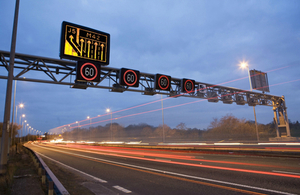Smart motorways – our current position
Highways England has released the following statement to the media in relation to recent commentary about smart motorways.

A Highways England spokesperson said:
Any death on our roads is a tragedy, and safety is always our number one priority.
The Department for Transport is considering a range of evidence during its stocktake. We expect the results to be published shortly and to provide the most up-to-date assessment of the safety of smart motorways. We are committed to implementing any new recommendations as part of our ongoing work to make our roads even safer.
Further information
- Our motorways are some of the safest in the world, and they are three times safer than A roads and six times safer than single carriageway A-roads (as sourced from report road casualties on the SRN 2017).
- Smart motorways have a range of protection measures in place which are not present on other types of high-speed roads. These include CCTV coverage, sensors to detect the flow and speed of traffic, electronic signs to close lanes, display warning messages and slow down approaching traffic.
- On average over the last five years around one in 12 fatalities on conventional motorways happened on a hard shoulder.
Recovery operators
- Vehicle recovery operators are never expected to work in a live lane, and their safety – and the safety of all road users – is our top priority.
- Measures should be in place to ensure this is the case (e.g. emergency traffic management, reduced speed limits and Traffic Officer support) before recovery operators attend a broken-down motorist. Vehicle recovery operators can also get to broken down motorists in emergency areas on smart motorways which are safer than working on a hard shoulder as they are set back from the live carriageway.
- Smart motorways have safety mitigations that are not present on other types of high-speed road, for example variable speed limits and red X, and we have also worked closely with the recovery industry to develop guidance on safe recovery. This involved carrying out a successful joint exercise to test different recovery scenarios.
Stopped vehicle detection
- Incident detection is already in place on all smart motorways.
- Stopped vehicle detection, operational on the M25 and in construction on the M3, uses scanning radar to identify stopped vehicles, set signs and alert our control rooms. It is effective in all weathers and at all levels of traffic.
- However, this is just one of the systems in place on smart motorways, including CCTV, incident detection, SVD and emergency areas – to keep drivers safe. The stopped vehicle detection system employed to date uses radar technology (radio waves) to detect stationary vehicles on motorways.
Red X signals
- It has always been an offence to ignore a red X.
- Police are now able to use cameras as part of the enforcement of red X.
Get further information about smart motorways
General enquiries
Members of the public should contact the Highways England customer contact centre on 0300 123 5000.
Media enquiries
Journalists should contact the Highways England press office on 0844 693 1448 and use the menu to speak to the most appropriate press officer.